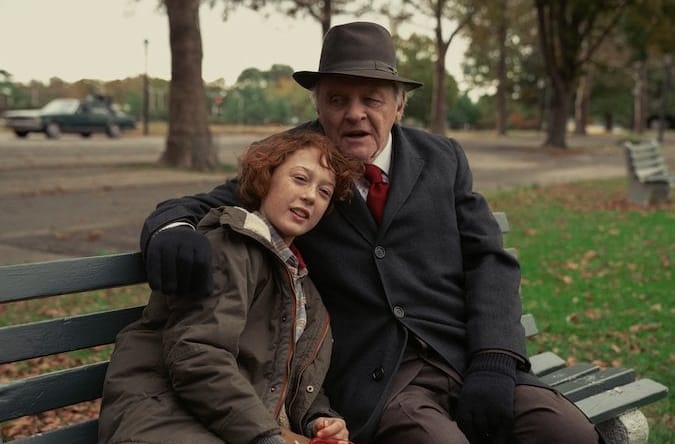
Armageddon Time, the latest film from James Gray, is set in 1980, a year that Gray marks as the end of a kind of 1960s honesty and idealism and the beginning of a Reagan-era pursuit of profit at all costs. Gray was born in 1969, and some of his biggest heroes are from that era: Even today, he’s moved by the Beatles’ decision to stop touring in August 1966, despite what it might mean financially, because their art would suffer from spending every night singing into, as Gray puts it, “a wall of screaming girls.” The next year, 1967, Muhammad Ali refused to be drafted to fight in Vietnam, a war he didn’t believe in. His decision led to a three-year ban from boxing at what likely would have been the peak of his career, and he was nearly sent to prison for draft evasion.
“One of the many crises of our age,” says Gray, “is our inability to figure out how to monetize integrity.”
1980 is the year that Ali lost a humiliating fight to Larry Holmes, John Lennon was shot dead outside his New York home, and Reagan was elected president. It is also the year Gray turned 11. Armageddon Time begins with two boys becoming friends at their Queens, New York public school: Paul (Michael Banks Repeta) is Jewish and Johnny (Jaylin Webb) is Black. Their friendship unexpectedly alters their lives in ways shaped by unfairness beyond their control. At the urging of his parents (Anne Hathaway and Jeremy Strong), and with help from his grandfather (Anthony Hopkins), Paul ends up going to a private prep school where Fred Trump looms large. The father to a future president rejects handouts to the poor while giving them to his own children. Unjust compromises are made, in search of comfort and money.
Also Read: Ana de Armas and Andrew Dominik on Sex and Violence in Blonde (Cover Story)
Paul is very much a stand-in for Gray, and Armageddon Time is as autobiographical as any film James has made. Since his 1994 debut, Little Odessa, released when he was 25, Gray has often taken inspiration from his Jewish grandparents’ emigration from Western Ukraine, which was then part of the USSR, to Queens, where he grew up. Even films that have no mention of his heritage, like 2016’s Lost City of Z and 2019’s Ad Astra, are about explorers in search of new worlds. The quality of his work draws stars like Joaquin Phoenix, Marion Cottilard and and Robert Pattinson, but he tries to avoid big budgets, or at least the compromises they often require.
“I don’t have inherited wealth or anything, but I also don’t have huge requirements financially,” he says. “I don’t care about flying private or having three houses. And so if I’m willing to live the way I live, can I keep working in this mode? It’s not easy sometimes. But if I can’t do it, who can?”
With Ad Astra, starring Brad Pitt as an astronaut in search of his father, he made an exception to his policy of not letting money interfere with art — and regrets it. He did not have the final cut on the big-budget film, which he now considers “a terrible mistake.”
We asked Gray to tell us about each stage of making Armageddon Time — development, screenwriting, production, post-production, and distribution — but quickly found that it wasn’t easy to say where one stage ended and the next began. In a way, he’s been making Armageddon Time since he was born. Here he is describing the process of making Armageddon Time, as told to MovieMaker’s Tim Molloy. His recollections begin in Paris, as he mourned the fate of Ad Astra. — M.M.
Chapter 1: Directing

James Gray
James Gray: I had a very difficult experience on my prior film, which was very painful on many levels. It’s not my cut of the movie that was released and is out there in the world. And that was very painful, because as the writer-director, you know, I took the credit or the blame for something that wasn’t really mine.
I went off to direct an opera in Paris, in November of 2019. And I really sort of tried to reassess my place, and what the point of it all was, and why I loved the cinema in the first place. And why I wanted to pursue that dream of being a creative person. And it was just part of a reassessment, to get as personal as I could and to be able to control the material as well as I could, and express a part of my soul.
So I wrote it fairly quickly during the rehearsal of the opera, because I was by myself. My wife and children had not come to Paris, until the last two weeks. It was probably about six weeks of outlining. And then I had a pretty clear idea of what the story was, by the end of that six-week period. And then the writing of the specific outline took about five months, and right around when the lockdown hit, I had my first draft. It was pre-George Floyd.
I didn’t know how to process Floyd, because you don’t want to seem trendy around issues like this. It sort of cheapens it in a way.
Oppression is a very complex thing. You can be both the oppressor and the oppressed at the same time. A lot of times the issue is made very binary: There are bad people and good people. We’d love to see the world in those terms. But it’s more complicated than that. You can be a family of American Jews, for example, and have a history of trauma, and at the same time, be part of a system that is oppressing people.
Everybody — everybody — is capable of contributing, in some way, to a kind of oppression. It’s not a comforting thought. We like to think of a racist person or an anti-semitic person as being identifiable by a white hood and a burning cross on your lawn. Those people, of course, do exist — in appallingly large numbers. They’re hopeless. (I mean, maybe a massive education program or something could help. Certainly wouldn’t hurt.)
But it’s more complicated than that. Every time you give your kid a piano lesson or a tutor for math, you are doing your own little part to contribute to an unfair world. And every act that you do in life carries with it compromise. You buy a pair of sneakers: Where are they made, and by whom? There’s no act that you can perform that is not on the back of somebody’s misery.
I’ve spent my whole life thinking this way. I have a lot of feelings about what I frankly did wrong in my life, which is not the same thing as feeling guilt, by the way. Because feeling guilty about an action localizes it, makes it about me. And it’s not about me, it’s about the built-in paths in the system that become unavoidable. And that is its own form of anguish.
Chapter 2: Screenwriting
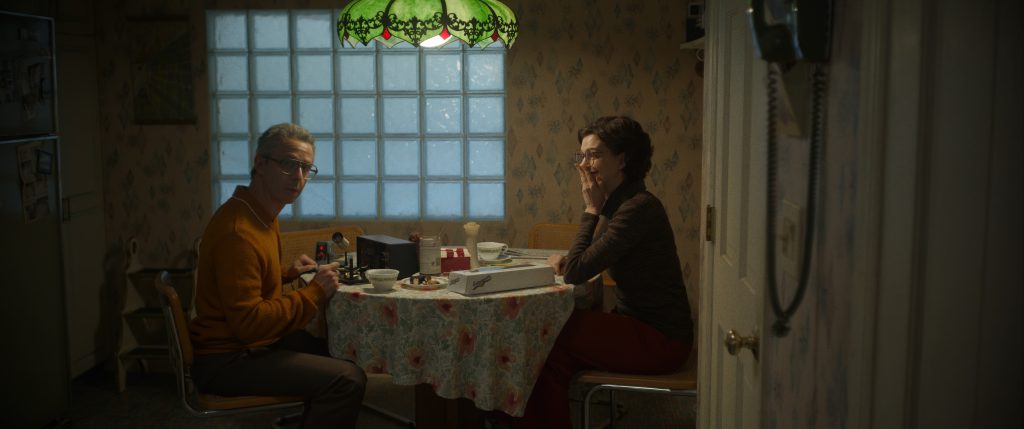
Jeremy Strong stars as Irving Graff and Anne Hathaway stars as Esther Graff in Armageddon Time, by James Gray. Courtesy of Focus Features
James Gray had a rule for Armageddon Time: “I tried to make up nothing.” While the film isn’t strictly autobiographical, it is based on his real childhood and real conclusions about the way life works. In this chapter on screenwriting, he shares his thoughts about what art is supposed to do, and what it can’t. — M.M.
James Gray: The truth of the matter is, you always have to do some condensing. In reality, there’s a longer timeframe. But it’s not far off at all. I tried to stay as personal as I could with the material. And I tried to get the details right. I tried to get the plates that we ate off of, and we did; the hat that my grandfather wore, and we did; the chandelier that we had in the dining room, the wallpaper, the kitchen appliances. And those are just the surface elements, of course.
Again, we get back to the Beatles and Ali as these ’60s icons. It was the honesty of those figures that was such a shock — and really moving for a person who aspired to art. And so I tried to get to that place to say, Here are my parents – or a version. It’s not autobiographical, really. Autobiographical means they’d have my parents’ names, and would wear exactly what they wore. It’s a little bit of a fantasia of my youth. So it’s personal, but not really autobiographical in that way. A lot of the facts are the same. But even there, it’s been dealt a grace that it didn’t have in life, as it needs to be, I think.
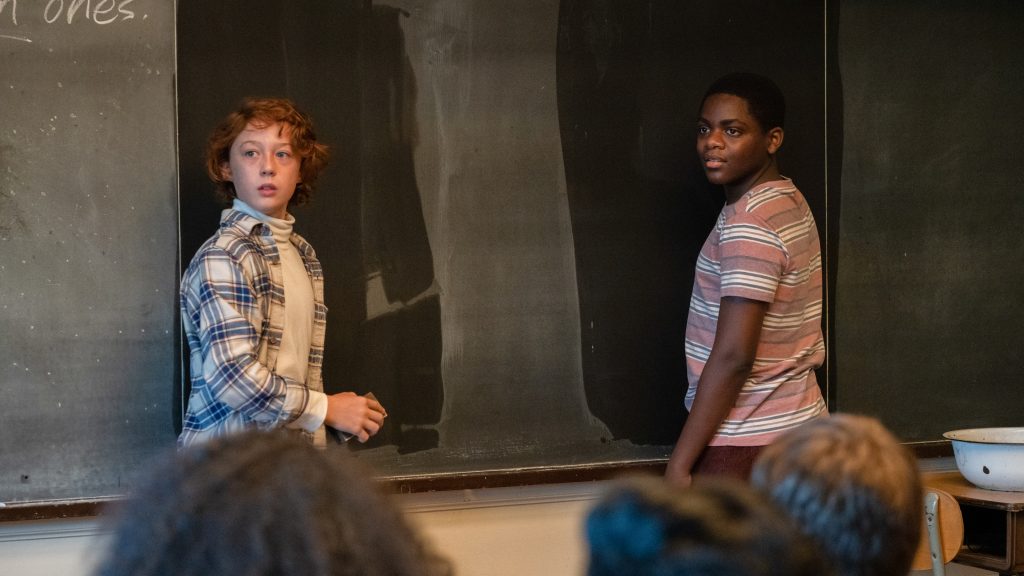
Michael Banks Repeta, left, stars as Paul Graff and Jaylin Webb stars as Johnny Crocker in Armageddon Time, by James Gray. Photo by Anne Joyce, courtesy of Focus Features
The M.O. in the movie was warts and all — this is who we were. And to do the sort of opposite of a virtue signaling, where you say, Look at these assholes and look at how much better I am. But to say, We’re all complicit, this is what it looks like.
You can’t point fingers at specific people a lot. You can’t say what the father does is the act of a jerk. It’s not. He has this son he loves.
This is not to say there’s no answer. Not at all. But it is not the function of the artist, if I may use that dirty word, to express positive qualities of the world, to make or manufacture an advertisement for American capitalism and its excellence. It’s not the job of the artists to do that.
It’s the job of the artists to express what’s wrong with the world — the thorn inside the rose.
I purposely try to stay out of what is in vogue, because what’s fresh today is rotten tomorrow. I try to stay true to myself. But I think it’s the function of artists to create a work which is provocative and unpleasant and uncomfortable in some key aspects. And if you say, I’m triggered, or it’s upsetting in some way, that’s a very good thing. It’s not the function of the artists to make you feel at home and good about yourself. That’s something that a glass of scotch might do, or the love of a dog. My dog comes up to me in the morning and jumps on me and licks me. It’s a nice feeling.
But that’s not what “Early Sunday Morning” by Edward Hopper tells me. It’s not what Francis Bacon tells me. The disquieting aspects of our world have to be conveyed in order for us to even think about trying to make the place better. So I think it’s my job to make you uncomfortable. To anger you a little bit. I would love it if people understood that that’s really part of the point of it all: “I don’t like it — doesn’t make me feel great.” Well, right.
I don’t know if you’ve been lucky enough to ever get to Madrid to see Goya’s Black Paintings in person. I’ve been once, and it was a brilliantly amazing experience. And he’s one of my favorite painters. And my reaction is not that I want to go buy a dresser for my house afterwards. It’s disquieting. But that’s our job.
Chapter 3: Directing
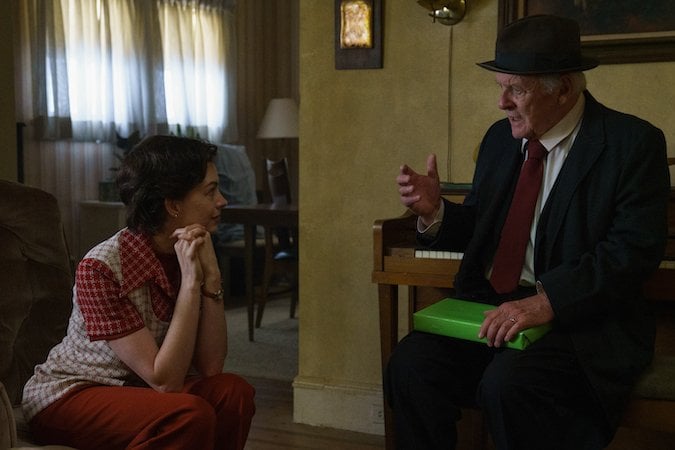
Anne Hathaway and Anthony Hopkins in Armageddon Time, by James Gray. Courtesy of Focus Features
Though Armageddon Time is far smaller in budget and scale than his previous film, Ad Astra, James Gray still draws A-list actors — from Anne Hathaway to Jeremy Strong to two-time Best Actor Oscar winner Anthony Hopkins to the latest Best Actress winner, Jessica Chastain, who dropped in for a day to play Maryanne Trump. How does Gray get them all?
“They work for nothing,” he explains. “And I’m hugely grateful to them. Because you say to them, in exchange for that, I’m going to give you a wonderful experience.”
How does that work, exactly? “You say, ‘I’m going to send you a script, I can’t pay anything, and in exchange, I’ll give you a fantastic experience.’ Pretty much like that.”
So he offers… a leisurely pace? “No, that’s the bad part, right? You have to move quickly,” Gray says. “But what’s fantastic about it is you can express yourself completely. You can do the work. You can be vulnerable. You can feel safe and protected as an actor, that your best work will be revealed. And you have to trust me, but that’s okay. That’s part of the process. If you don’t trust the director, you don’t have anything.”
For this chapter on production, we asked Gray how his direction has changed in his three decades of making films. He responded with a brilliant history of film acting, from the studio-system era to a Marlon Brando improvisation when Eva Marie Saint dropped a glove in 1954’s On the Waterfront, to another Brando film, 1972’s The Godfather, to Raging Bull, released in 1980, the year Armageddon Time takes place. — M.M.
James Gray: My process has been more or less the same since I started making films. I’m trying to think to myself how my process has changed. I guess I’ve gotten a little bit looser with actors.
In the 1930s, and ’40s, with a certain style of actor — in what they refer to now as the filmic representational style — Cary Grant hits his mark and says his line. It enabled you to do a lot of prep on where you’d put the camera. The reshoot process was very easy, because if you needed to reshoot scenes, you just got Spencer Tracy off Stage 7, because he was already under contract, and put him on Stage 2 to reshoot that stuff. It’s part of why the studio system was able to produce films of such narrative excellence, because it’s really hard to tell a story straightforwardly on film.
In terms of degree of difficulty, the number-one film is The Godfather: Three hours, not-showy technique, pure story, pure character, major ellipses in time — total coherence. Tremendous emotional power.
We’ve talked about the Beatles. You have very silly people who declaim Ringo Starr’s drumming. The brilliance of any artist, a lot of the time, is knowing when not to play. Or when to give something space. It’s not to jam it up with a bunch of visual effects or camera moves for no reason. That stuff is a distraction.
Now, it can be done brilliantly, obviously. If you look at something like Raging Bull, the camerawork in the boxing scenes is very flamboyant. But it’s a work of genius, because it’s contrasted with these scenes of domestic life that are actually quite simply and restrainedly shot.
So you can do it with a purpose, but without a purpose, it’s like, Whaa? And sometimes we lose sight of that. So my own process has, in some ways, become more accommodating to the actor. Realizing that once Montgomery Clift and Marlon Brando changed the language — once Marlon Brando decided to reach for the glove and pick it up — you have to accommodate. Where you put the camera becomes a very unsubtle compromise between what the actor requires and what the film requires. So I think I’ve embraced that compromise more than I used to. I respect the actor more.
Chapter 4: Post Production
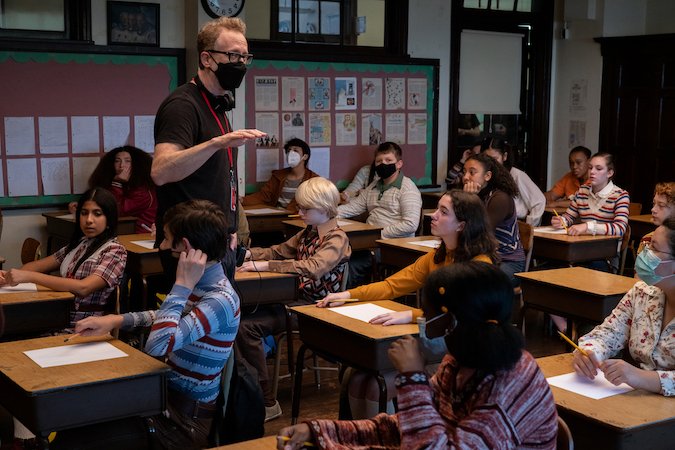
James Gray directs a scene. Photo by Anne Joyce, courtesy of Focus Features
James Gray says post on Armageddon Time was better than on his prior film, Ad Astra, for a simple reason: “I had final cut.” He declined to get into “spilt milk territory” about who took it away and why, because “it’s not helpful,” adding: “And by the way, it’s also boring. Really boring to get into the weeds on that.” —M.M.
James Gray: The shooting of Ad Astra was actually quite pleasant, for the most part. I mean, it was mechanically difficult and technically difficult. But I was still telling something quite personal. I loved what Brad Pitt was doing in the movie. And so I was very heartened during the shoot. It was actually the post process that unwound the film.
“Final cut” does not mean that it’s 100% representative of your ideas. In fact, it means quite the opposite. For me, final cut means that you have the ability to embrace the ideas that expand your original notion — and take the credit. (I’m kidding about the last part, of course.)
It’s the director’s job to embrace the ideas that expand the notion of the film and get rid of the ones that get in the way. And so when you have final cut, you can be open, ironically. And when you don’t have final cut, and when the ideas of others are more important than yours, and you’re the writer-director, then the waters get very muddied. And the work is necessarily compromised. Some of that comes down to budget — what the perceived risk is. But I made that choice to give up final cut on Ad Astra, which was a terrible mistake. And so I vowed that, if a film has my name on it, particularly as the writer director, I can’t have that happen again.
Post on Armageddon Time was joy. I got up in the morning, went into my guest house, turned on my computer system and my projector, and logged in with the editor, who was in New York. And though I’m in Los Angeles, it was like I was in the room with him. It was strange. I’d have liked to be in the room with him, it’s better. But we didn’t miss a beat.
The painful part was that my father died in the middle of post, of COVID. I was thrown. But I didn’t have the time to really process it at all. Because I was on schedule, and I just worked straight through it. And, you know, that was very sad. It’s a very sad turn of events, although he was quite old, and I was on very good terms with him.
But the post process, in general, was beautiful. The only thing I had a problem with was going to the Cannes Film Festival, because we had to go to Cannes with a three-day temp dub. And I felt that the film made major leaps forward with the sound mix after that: We changed some of the music cues, because some of the music scoring wasn’t done. There are a few new lines in there. And I think it makes an enormous difference. I think people watching the film now are seeing a better movie.
Chapter 5: Distribution
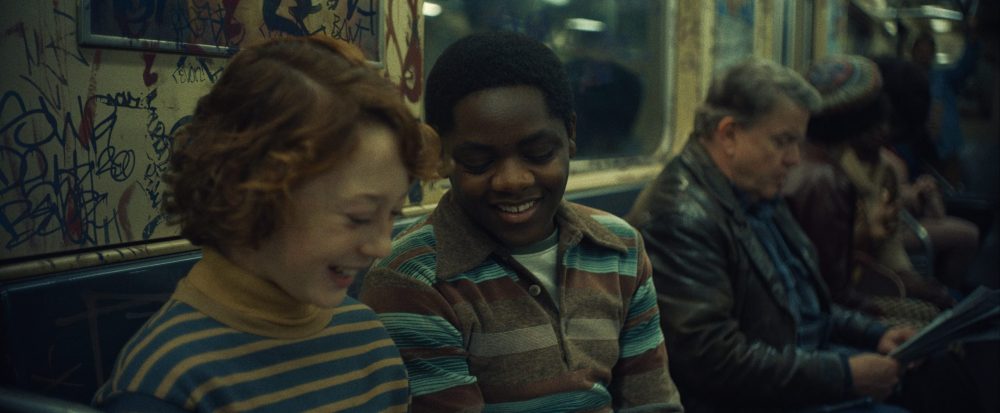
Michael Banks Repeta stars as Paul Graff and Jaylin Webb stars as Johnny Crocker in Armageddon Time, written and directed by James Gray. Courtesy of Focus Features
James Gray is delighted with Focus Features’ distribution plan for Armageddon Time, which involves a solid theatrical run before it becomes available digitally. And while he knows many people will watch it at home, he says he spent “not one moment” thinking about how the film would play on smaller screens, as he explains in this chapter. — M.M.
James Gray: I hope that the streaming thing means a little bit of the pressure about opening weekend is removed — that in a way, it becomes the trailer for your streaming release. My representatives were all happy that it’s getting a theatrical release of real prominence — three weeks exclusive in the theater. Ten years ago, you would have been crestfallen. And today, it’s fantastic.
That’s about the studios making a major investment in the long-term health of the theatrical marketplace. It is past my pay grade. I can’t begin to get into the weeds on that. I can’t begin to do anything about it, except to keep doing the work I’m doing and hoping for the best. It’s a real sadness that a lot of people in the country and the world have gotten out of the habit of going out to the movies, partly because of the pandemic. But these things were in place even before that. The pandemic has only exaggerated those things.
I did not compromise a single composition for the small screen. And the truth is something like 45% of Americans now have home theaters — some outrageously high number. So very few people are going to see it in the wrong aspect ratio now. It’s not like 1986 where everyone watched it 1:33. Very few people are going to see it on a very small screen. There are people who are going to watch it on the iPhone, but no amount of compositional help can accommodate for watching your movie on an iPhone. The screen is too small. The biggest closeup in the world is not going to help you out.
I just compose stuff the way I like it for the big screen, including the big flat-screen TV. That’s all you can do.
I had a strange experience once in the Art Institute of Chicago. My wife was doing a charity thing — she was on the board of a charity there — and I had a day off while she was working. So I decided, ‘I’m going to go to the Art Institute of Chicago. I’m going to look at some art. It’s a fantastic museum — room after room of recognizable masterpieces: Grant Wood’s “American Gothic,” and Edward Hopper’s “Nighthawks,” And George Seurat’s “Sunday in the Park” and Van Gogh’s self-portrait. Just unbelievable. I was looking at a Picasso, and then in the corner was some work of art that was totally magnificent by a painter I’d never heard of. But it moved me greatly. And you realize that none of it matters — you’re just doing your own little thing to try and contribute to that mountain of human endeavor that we call progress. And in the end, that is all you can do.
Armageddon Time is in theaters October 28.
This conversation with James Gray about Armageddon Time is adapted from our latest issue, our annual Complete Guide to Moviemaking, featuring Ana De Armas and Andrew Dominik on the cover and on sale now.
Share:

